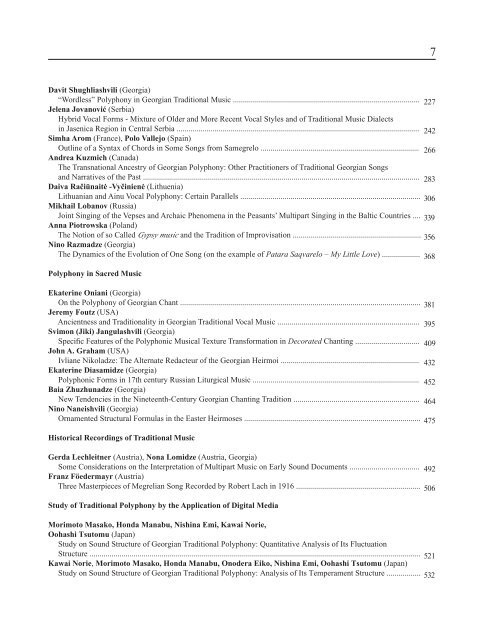The Fifth International Symposium on Traditional Polyphony ...
The Fifth International Symposium on Traditional Polyphony ... The Fifth International Symposium on Traditional Polyphony ...
6 C O N T E N T S From the Editors ............................................................................................................................................................ 12 Asian Traditional Polyphony Joseph Jordania (Australia, Georgia) Traditional Polyphony in Asia: Problems and Perspectives ....................................................................................... 24 Münir Nurettin Beken (USA) Virtual Heterophony: Composition, Variation, Texture and Memory in Turkish Classical Music ............................. 36 Nino Tsitsishvili (Australia, Georgia) A Comparative and Interdisciplinary Study of East Georgian Polyphonic Song Styles in the Context of Middle Eastern and Central Asian Monophonic Music .......................................................................................... 50 Michael Tenzer (Canada) Polyphonic Aspects of Balinese Gamelan Music ....................................................................................................... 63 Yu-Hsiu Lu (Taiwan) Development of a New Polyphonic Style – Case of the Taiwan Aborigines .............................................................. 77 Marina Kavtaradze, Ekaterine Buchukuri (Georgia)
Davit Shughliashvili (Georgia) “Wordless” Polyphony in Georgian Traditional Music ............................................................................................. 227 Jelena Jovanović (Serbia) Hybrid Vocal Forms - Mixture of Older and More Recent Vocal Styles and of Traditional Music Dialects in Jasenica Region in Central Serbia ......................................................................................................................... 242 Simha Arom (France), Polo Vallejo (Spain) Outline of a Syntax of Chords in Some Songs from Samegrelo ............................................................................... 266 Andrea Kuzmich (Canada)
- Page 1 and 2: m o x s e n e b e b i 4-8 oqtomberi
- Page 3 and 4: s a r C e v i redaqtorebisagan ....
- Page 5: franc foedermairi (avstria) megruli
- Page 9 and 10: edaqtorebisagan winamdebare krebulS
- Page 11 and 12: edaqtorebisagan koleqcias. moxseneb
- Page 13 and 14: From The Editors G
- Page 15: aziuri tradiciuli polifonia ASIAN T
- Page 18 and 19: 18 ioseb Jordania anobis arsebuli t
- Page 20 and 21: 20 ioseb Jordania mkvlevarebis yura
- Page 22 and 23: 22 ioseb Jordania xmianobasTan da T
- Page 24 and 25: 24 TRADITIONAL POLYPHONY IN ASIA: P
- Page 26 and 27: 26 Joseph Jordania scholar Schehera
- Page 28 and 29: 28 Joseph Jordania 2. Asian polypho
- Page 30 and 31: 30 Joseph Jordania gestion not only
- Page 32 and 33: 32 virtualuri heterofonia: kompozic
- Page 34 and 35: 34 munir nuretin bekeni (aSS) migvi
- Page 36 and 37: 36 MÜNIR NURETTIN BEKEN (USA) VIRT
- Page 38 and 39: 38 Münir Nurettin Beken This becam
- Page 40 and 41: 40 munir nuretin bekeni. danarTi M
- Page 42 and 43: 42 nino ciciSvili (avstralia, saqar
- Page 44 and 45: 44 nino ciciSvili (2) reCitaciuli b
- Page 46 and 47: 46 nino ciciSvili upirveles yovlisa
- Page 48 and 49: 48 nino ciciSvili kulturis arsebobi
- Page 50 and 51: 50 NINO TSITSISHVILI (AUSTRALIA, GE
- Page 52 and 53: 52 Nino Tsitsishvili Factor 3: scal
- Page 54 and 55: 54 Nino Tsitsishvili A historical i
Davit Shughliashvili (Georgia)<br />
“Wordless” Polyph<strong>on</strong>y in Georgian Traditi<strong>on</strong>al Music ............................................................................................. 227<br />
Jelena Jovanović (Serbia)<br />
Hybrid Vocal Forms - Mixture of Older and More Recent Vocal Styles and of Traditi<strong>on</strong>al Music Dialects<br />
in Jasenica Regi<strong>on</strong> in Central Serbia ......................................................................................................................... 242<br />
Simha Arom (France), Polo Vallejo (Spain)<br />
Outline of a Syntax of Chords in Some S<strong>on</strong>gs from Samegrelo ............................................................................... 266<br />
Andrea Kuzmich (Canada)<br />
<str<strong>on</strong>g>The</str<strong>on</strong>g> Transnati<strong>on</strong>al Ancestry of Georgian Polyph<strong>on</strong>y: Other Practiti<strong>on</strong>ers of Traditi<strong>on</strong>al Georgian S<strong>on</strong>gs<br />
and Narratives of the Past .......................................................................................................................................... 283<br />
Daiva Račiūnaitė -Vyčinienė (Lithuenia)<br />
Lithuanian and Ainu Vocal Polyph<strong>on</strong>y: Certain Parallels .......................................................................................... 306<br />
Mikhail Lobanov (Russia)<br />
Joint Singing of the Vepses and Archaic Phenomena in the Peasants’ Multipart Singing in the Baltic Countries .... 339<br />
Anna Piotrowska (Poland)<br />
<str<strong>on</strong>g>The</str<strong>on</strong>g> Noti<strong>on</strong> of so Called Gypsy music and the Traditi<strong>on</strong> of Improvisati<strong>on</strong> ................................................................ 356<br />
Nino Razmadze (Georgia)<br />
<str<strong>on</strong>g>The</str<strong>on</strong>g> Dynamics of the Evoluti<strong>on</strong> of One S<strong>on</strong>g (<strong>on</strong> the example of Patara Saqvarelo – My Little Love) ................... 368<br />
Polyph<strong>on</strong>y in Sacred Music<br />
Ekaterine Oniani (Georgia)<br />
On the Polyph<strong>on</strong>y of Georgian Chant ........................................................................................................................ 381<br />
Jeremy Foutz (USA)<br />
Ancientness and Traditi<strong>on</strong>ality in Georgian Traditi<strong>on</strong>al Vocal Music ....................................................................... 395<br />
Svim<strong>on</strong> (Jiki) Jangulashvili (Georgia)<br />
Specific Features of the Polyph<strong>on</strong>ic Musical Texture Transformati<strong>on</strong> in Decorated Chanting ................................ 409<br />
John A. Graham (USA)<br />
Ivliane Nikoladze: <str<strong>on</strong>g>The</str<strong>on</strong>g> Alternate Redacteur of the Georgian Heirmoi ..................................................................... 432<br />
Ekaterine Diasamidze (Georgia)<br />
Polyph<strong>on</strong>ic Forms in 17th century Russian Liturgical Music ................................................................................... 452<br />
Baia Zhuzhunadze (Georgia)<br />
New Tendencies in the Nineteenth-Century Georgian Chanting Traditi<strong>on</strong> ............................................................... 464<br />
Nino Naneishvili (Georgia)<br />
Ornamented Structural Formulas in the Easter Heirmoses ........................................................................................ 475<br />
Historical Recordings of Traditi<strong>on</strong>al Music<br />
Gerda Lechleitner (Austria), N<strong>on</strong>a Lomidze (Austria, Georgia)<br />
Some C<strong>on</strong>siderati<strong>on</strong>s <strong>on</strong> the Interpretati<strong>on</strong> of Multipart Music <strong>on</strong> Early Sound Documents ................................... 492<br />
Franz Föedermayr (Austria)<br />
Three Masterpieces of Megrelian S<strong>on</strong>g Recorded by Robert Lach in 1916 .............................................................. 506<br />
Study of Traditi<strong>on</strong>al Polyph<strong>on</strong>y by the Applicati<strong>on</strong> of Digital Media<br />
Morimoto Masako, H<strong>on</strong>da Manabu, Nishina Emi, Kawai Norie,<br />
Oohashi Tsutomu (Japan)<br />
Study <strong>on</strong> Sound Structure of Georgian Traditi<strong>on</strong>al Polyph<strong>on</strong>y: Quantitative Analysis of Its Fluctuati<strong>on</strong><br />
Structure ..................................................................................................................................................................... 521<br />
Kawai Norie, Morimoto Masako, H<strong>on</strong>da Manabu, Onodera Eiko, Nishina Emi, Oohashi Tsutomu (Japan)<br />
Study <strong>on</strong> Sound Structure of Georgian Traditi<strong>on</strong>al Polyph<strong>on</strong>y: Analysis of Its Temperament Structure ................. 532<br />
7



